Sgt. Jesse McIntosh Scott
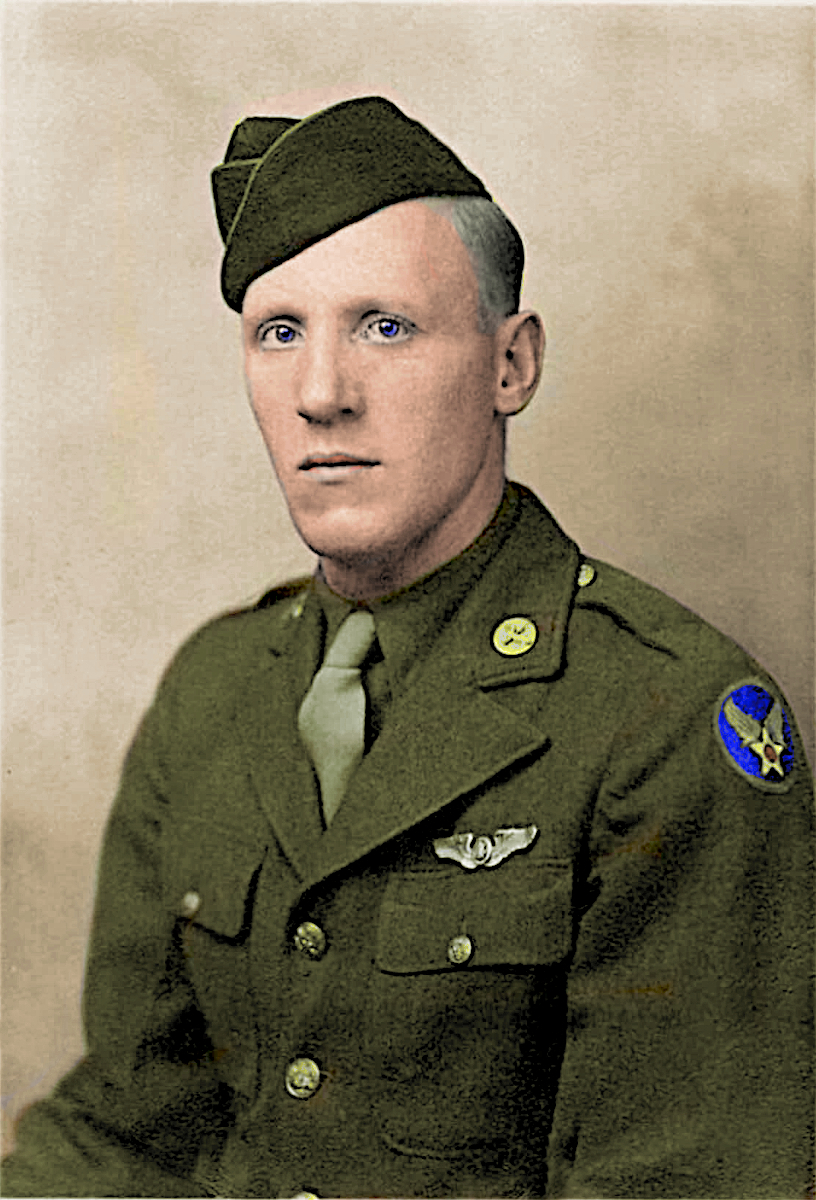
Sgt. Jesse McIntosh Scott flew with the 497th Bomb Squadron of the 344th Bomb Group. Click any image to enlarge.
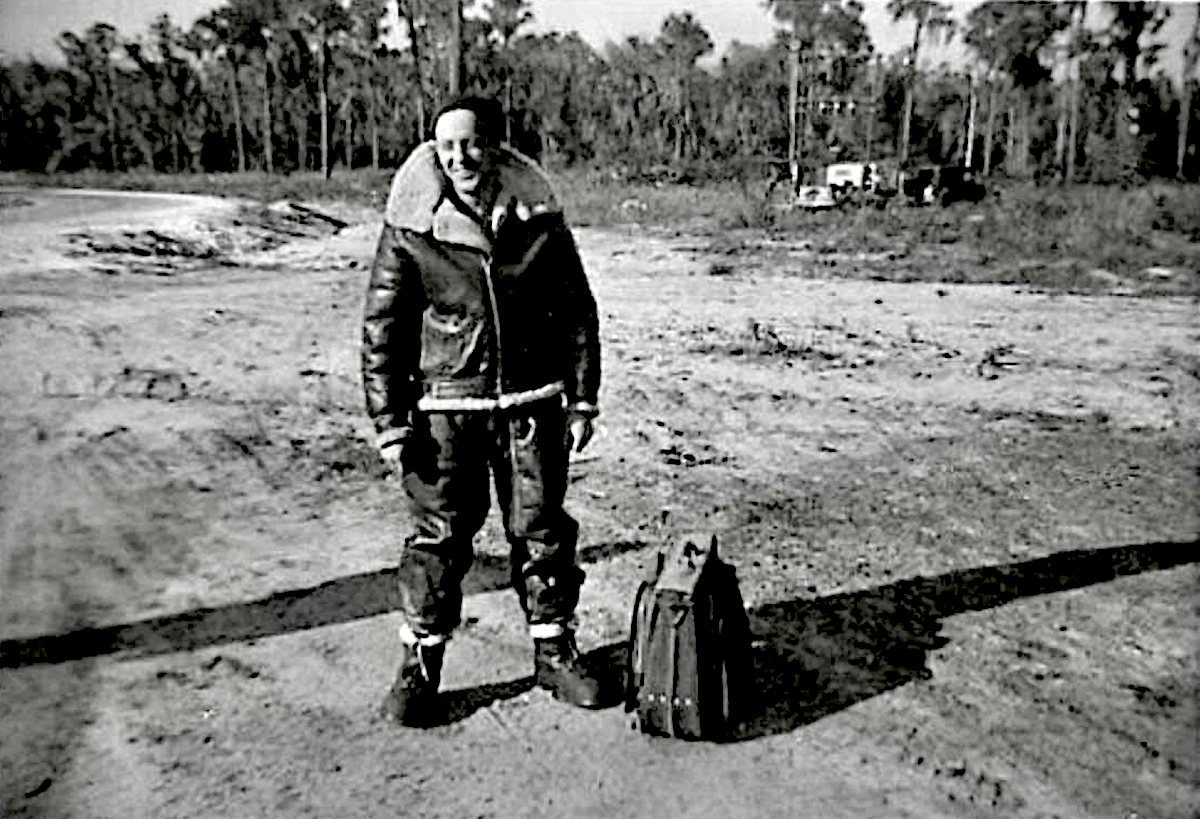
His roll in the crew was a bit unusual as he was a non-commisioned officer flying as the navigator bombardier. That role was usually filled by commissioned and specially trained officers. People in his role were called toggiliers. Basically, they would toggle the bombs away switch when they saw that the bombardiers in front of them dropped their bombs.
The earliest mission I could find was the morning mission of May 10, 1944.
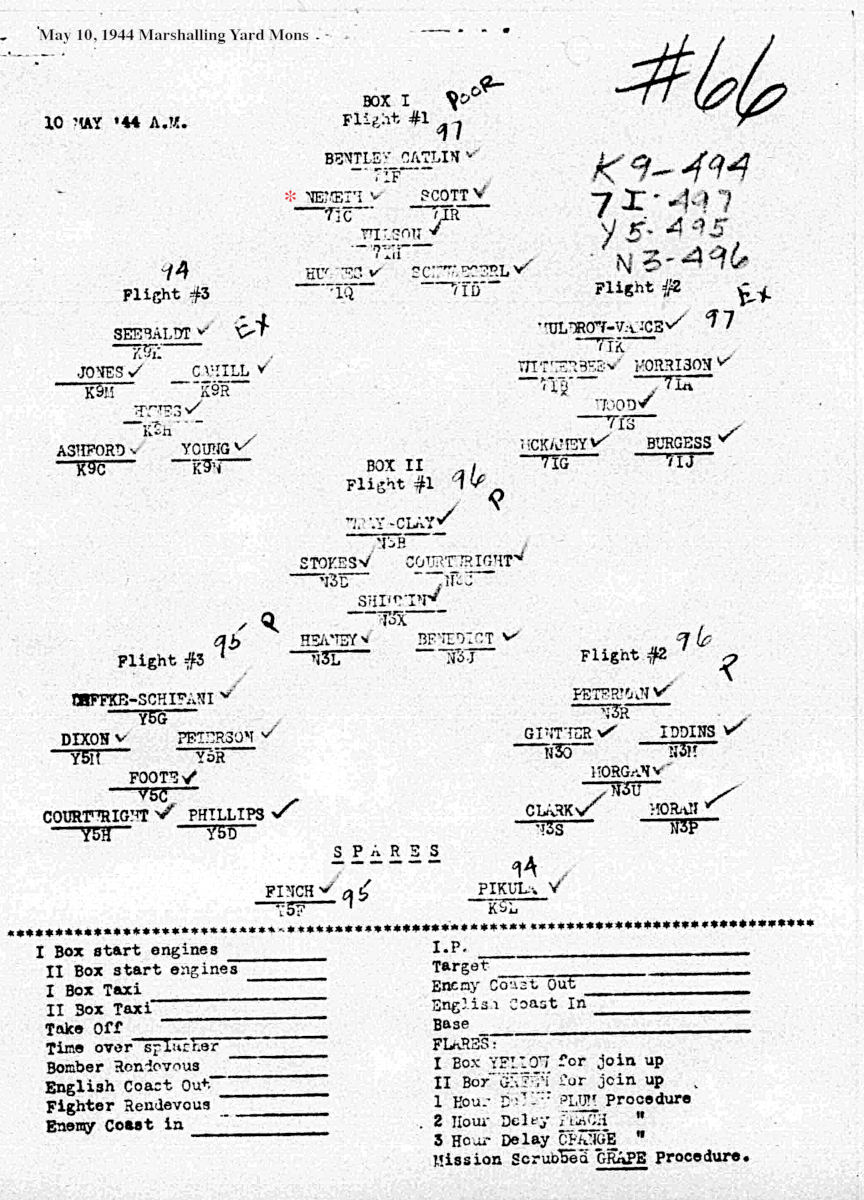
According to the formation diagram, Scott’s plane 7I-C was piloted by Nemeth in position 1-1-3.
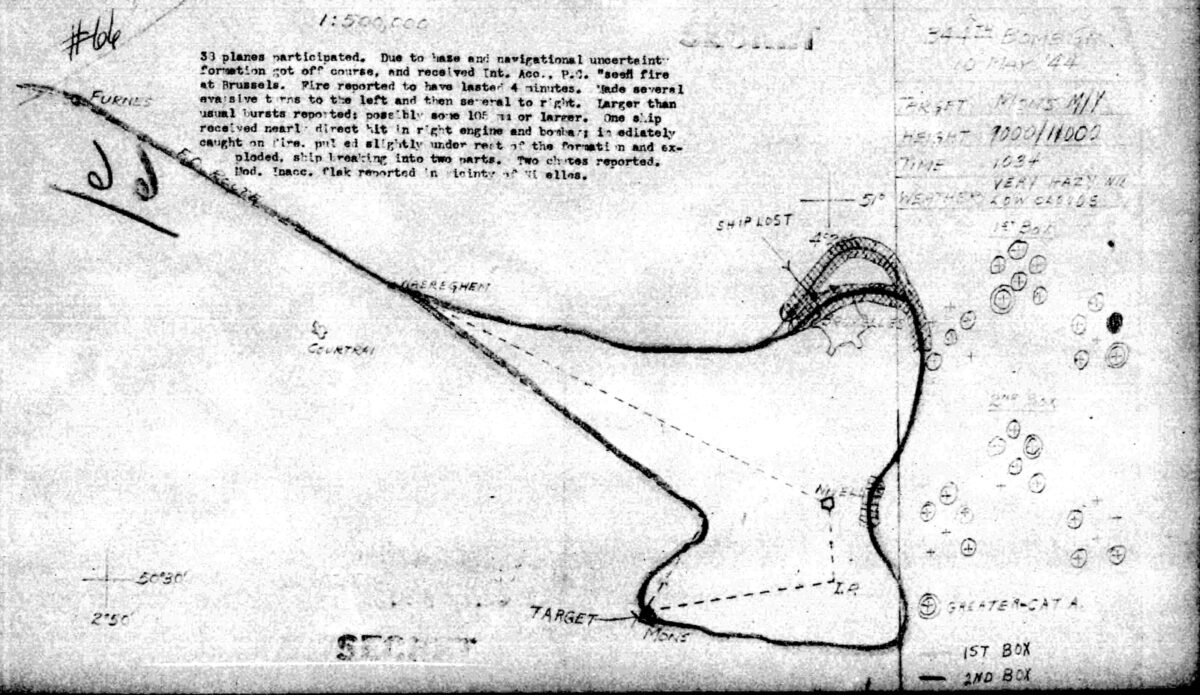
The mission was to bomb a marshalling yard in Mons, Belgium, about 10 miles from the French border. (see google map)
38 planes participated and experiences some unusually large flak bursts. They were perhaps fired by 105 mm guns as opposed to the usual 88’s. One plane was shot down. (see MACR 4511)
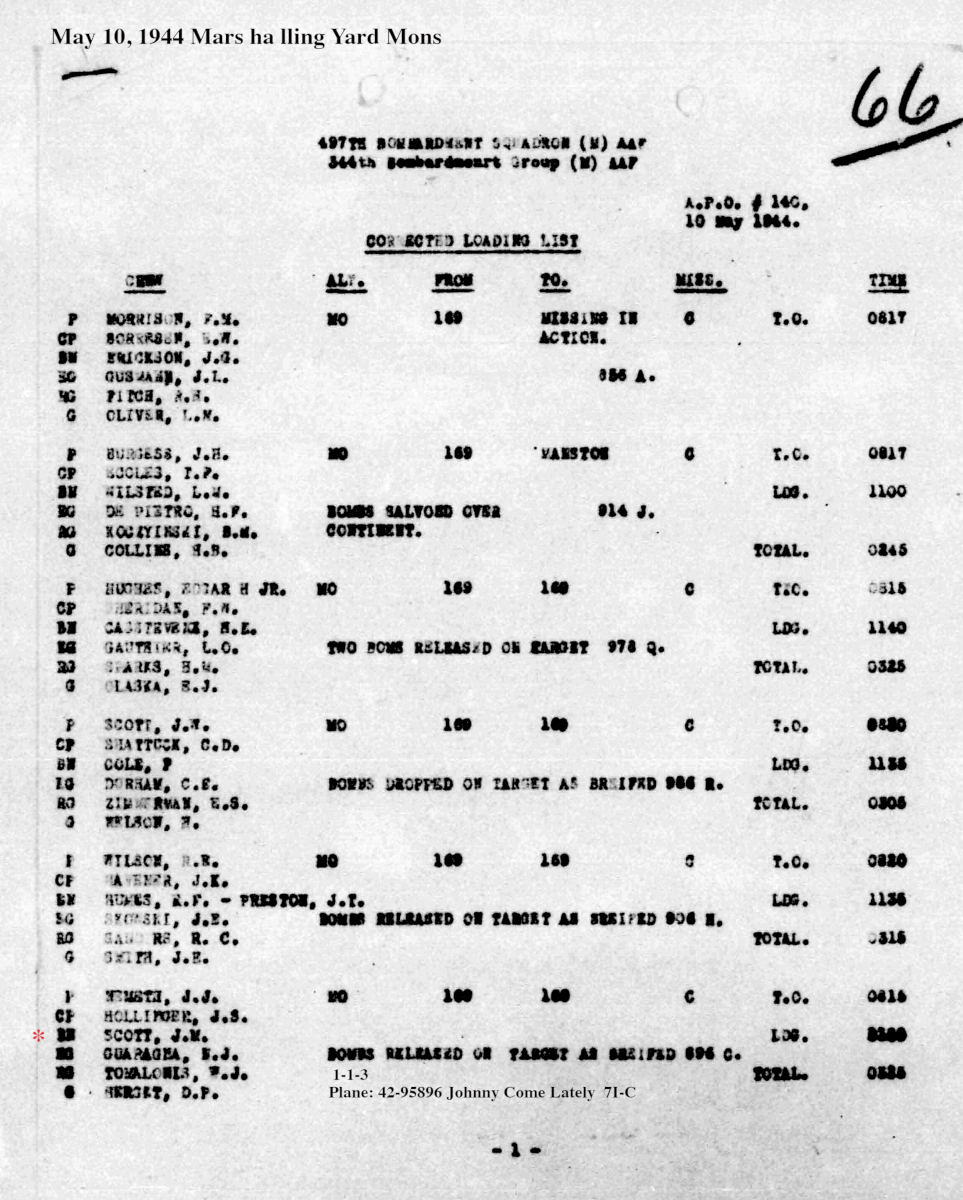
The load list indicates that the plane Jesse Scott and crew used was 42-95896 “Johnny Come Lately” 7I-C. The plane took off at 8:16 am and landed 11:36 am. The crew consisted of;
PILOT – Nemeth
COPILOT – Hollinger
TOGGILIER- Scott
RADIO/GUN – Tomalonis
ENG/GUN – Guaragna
TAIL/GUN – Herget
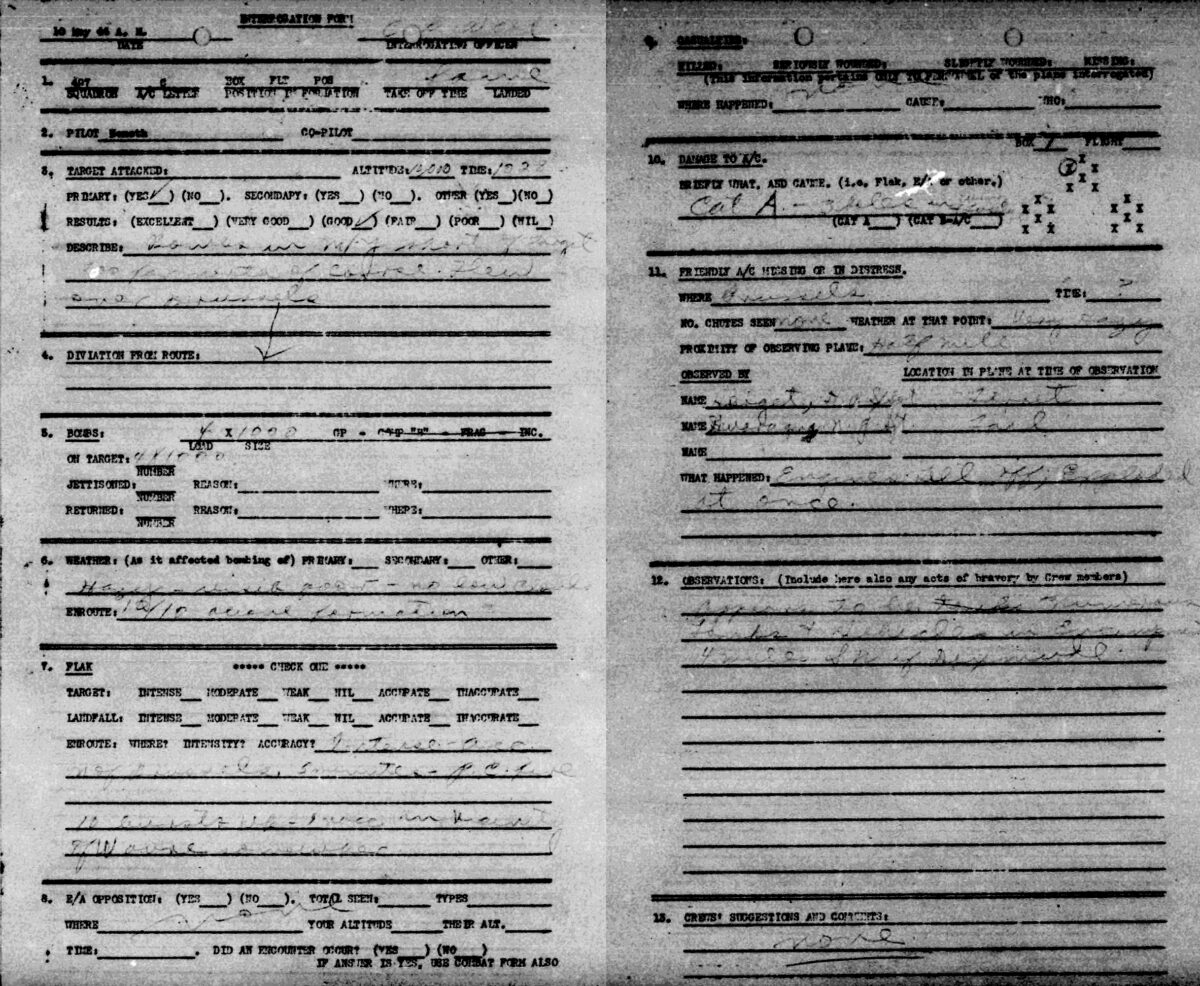
Nemeth reporting dropping his 4 – 1000lb bombs from 10,000 ft at 10:28. The bombs fell short of the target. He mentions that the formation flew off course and ended up over Brussels. This would explain the intense and accurate flak encountered. Nemeth described 42-95856 7I-A Fertile Mertile demise. He said his crewmen saw the plane hit by flak. An engine fell off and exploded immediately. No chutes were seen to leave the plane. It was very hazy. As it turned out three parachuted but were captured.
A second mission was flown the same afternoon of May 10, 1944.
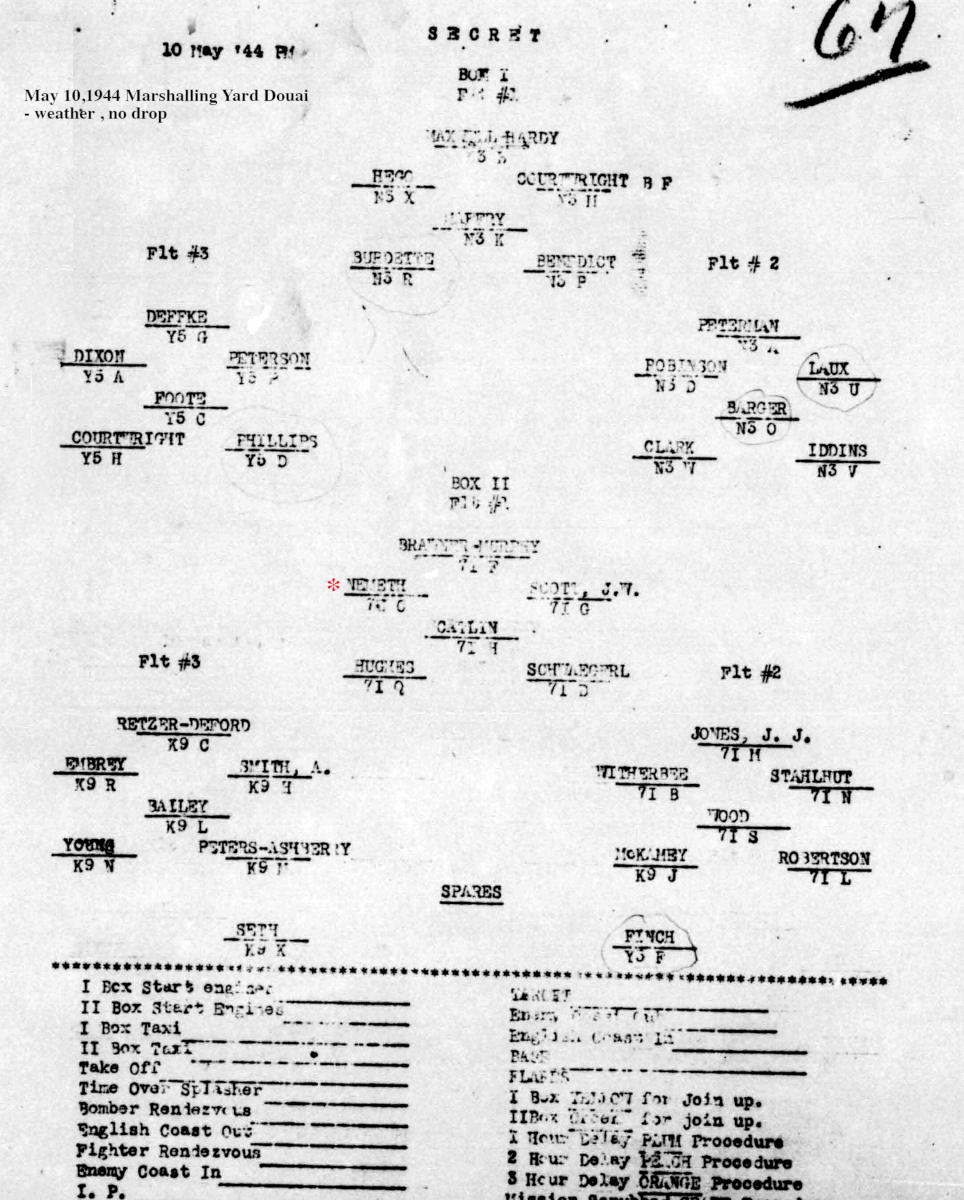
According to the formation diagram, Scott’s plane 7I-O was piloted by Nemeth in position 2-1-3.
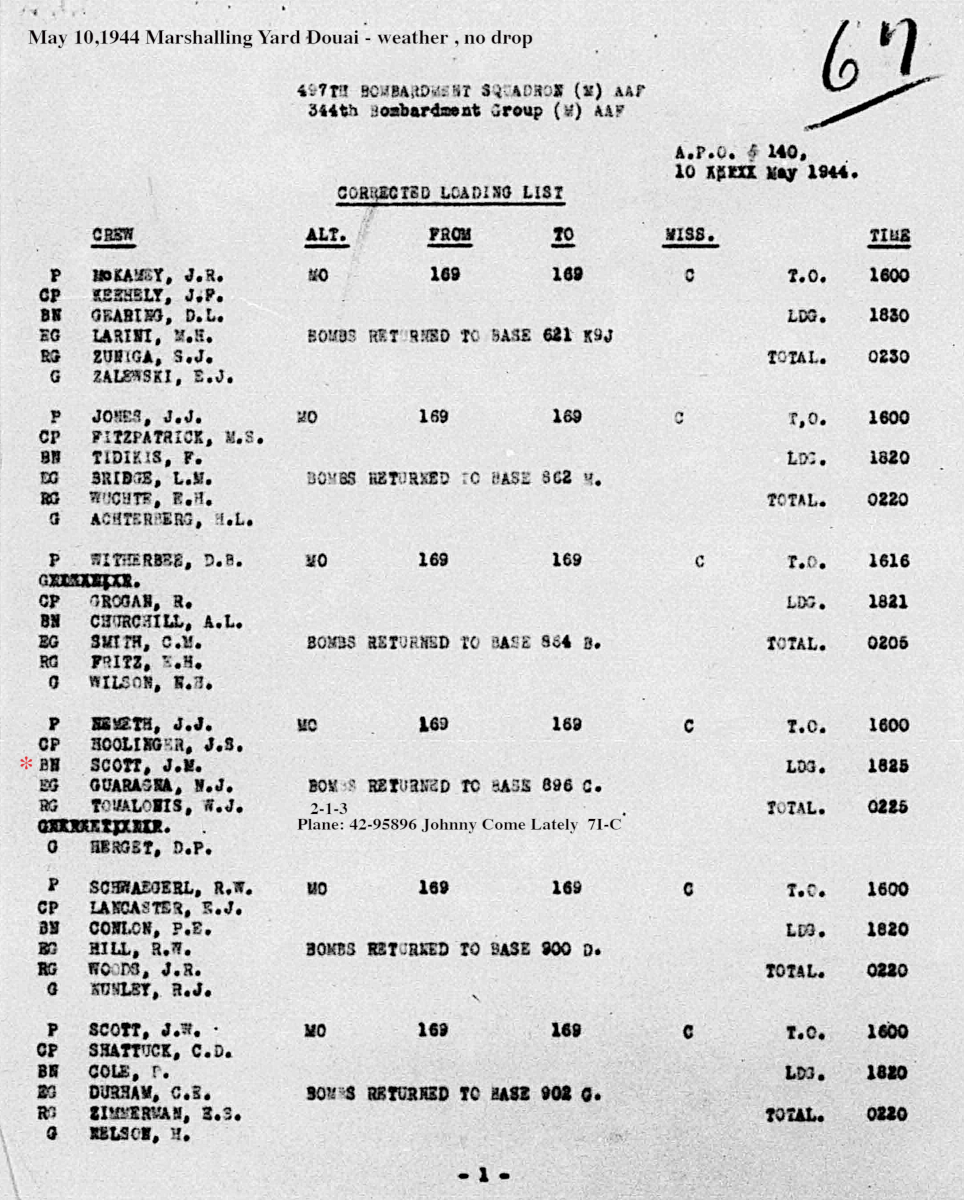
The second mission of the day, May 10,1944 was to a Marshalling Yard in Douai, France. Due to the weather, the bombs were returned to base. The load list indicates that the plane Jesse Scott and crew used was 42-95896 “Johnny Come Lately” 7I-C. The plane took off at 4:00 pm and landed 6:20 pm. The crew consisted of;
PILOT – Nemeth
COPILOT – Hollinger
TOGGILIER- Scott
RADIO/GUN – Tomalonis
ENG/GUN – Guaragna
TAIL/GUN – Herget
On June 4, 1944, the 344th BG attacked a bridge over Courcelles Sur Seine. No formation diagram is available.
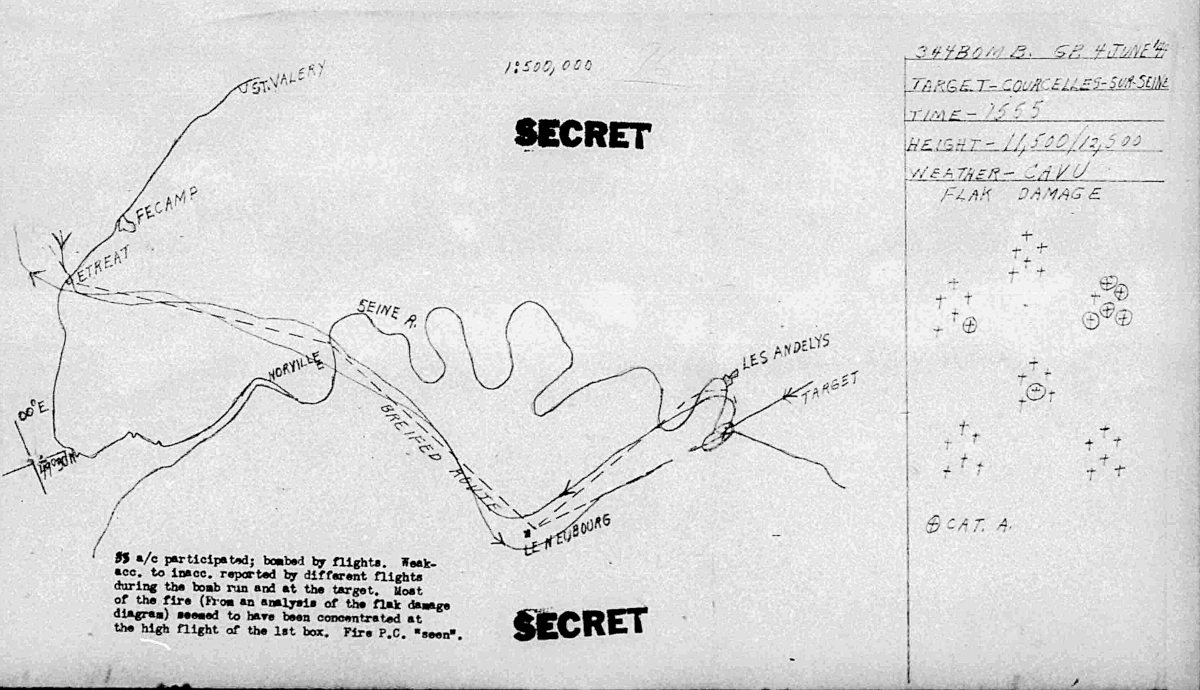
35 planes were in the formation. Seven received flak damage. At 3:55 pm the bombs were dropped from about 11,500 ft. The visibility at the target was unlimited.
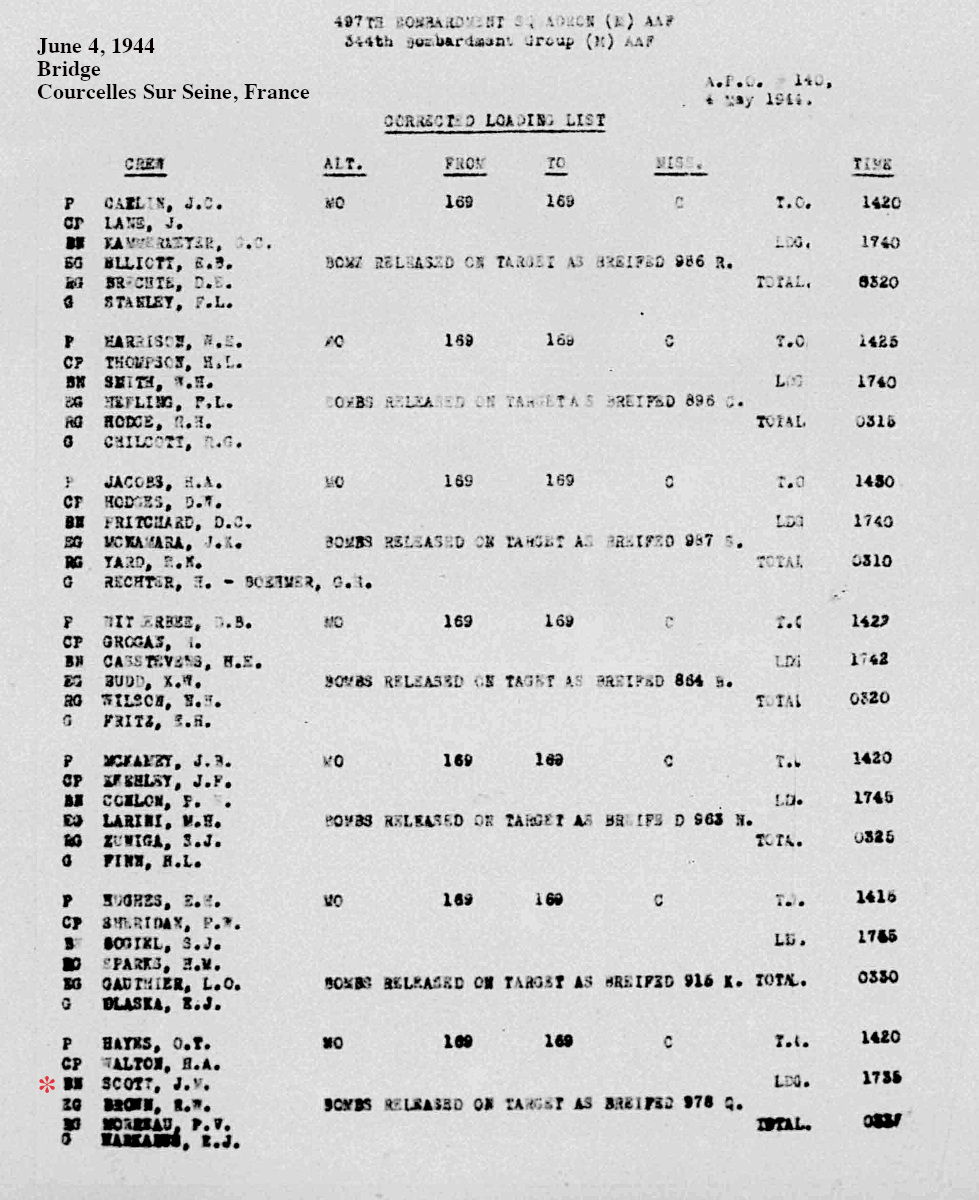
The mission of June 4, 1944 was to a bridge over Courcelles Sur Seine, France. Their plane took off at 4:00 pm and landed 6:20 pm. The crew consisted of;
PILOT – Hayes
COPILOT – Walton
TOGGILIER- Scott
RADIO/GUN – Moireau
ENG/GUN – Brown
TAIL/GUN – Warkasus (sp?)
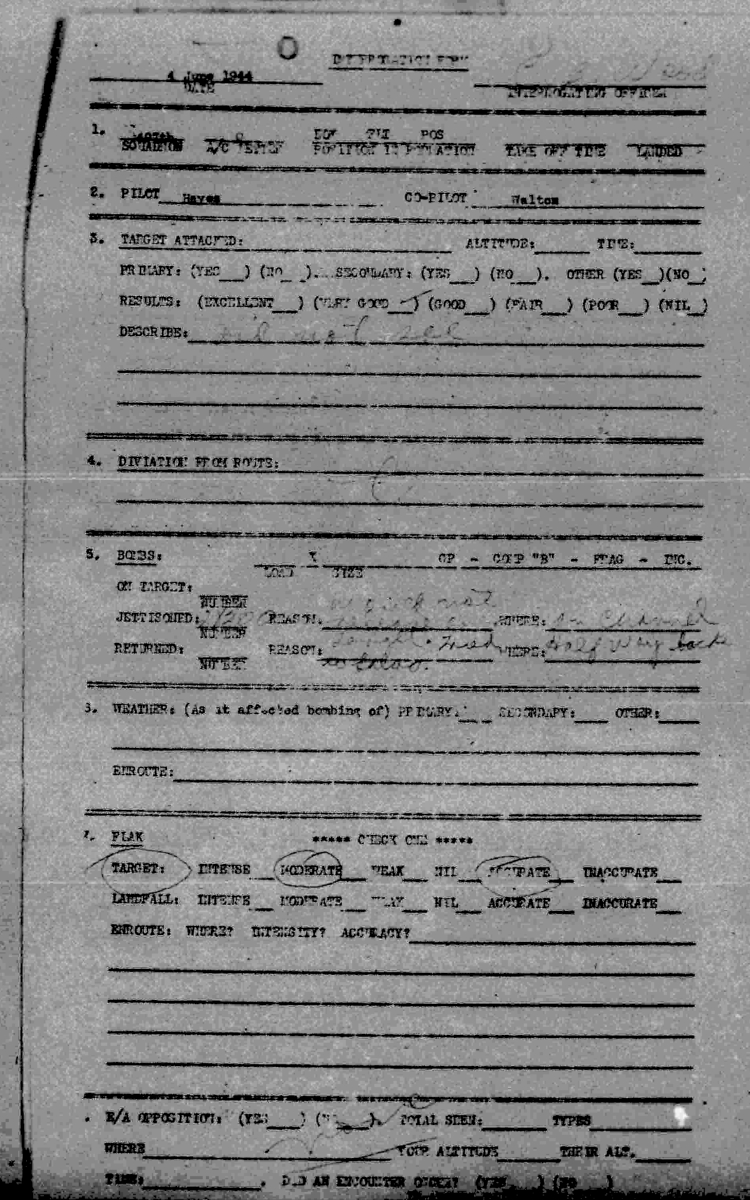
The plane used by Jesse Scott and crew is not legible. Hayes claims that the bombing results were very good. 2 of their 200lb bombs did not release over the target and were later jettisoned over the English Channel. They encountered moderate but accurate flak.
Sgt. Jesse M. Scott flew again the next day. On June 5, 1944 they attacked enemy headquarters at Wissant, France. This mission to the Calais area was intended to make the Germans beleive that D-Day would target Calais rather than Normandy. No formation diagram is available.
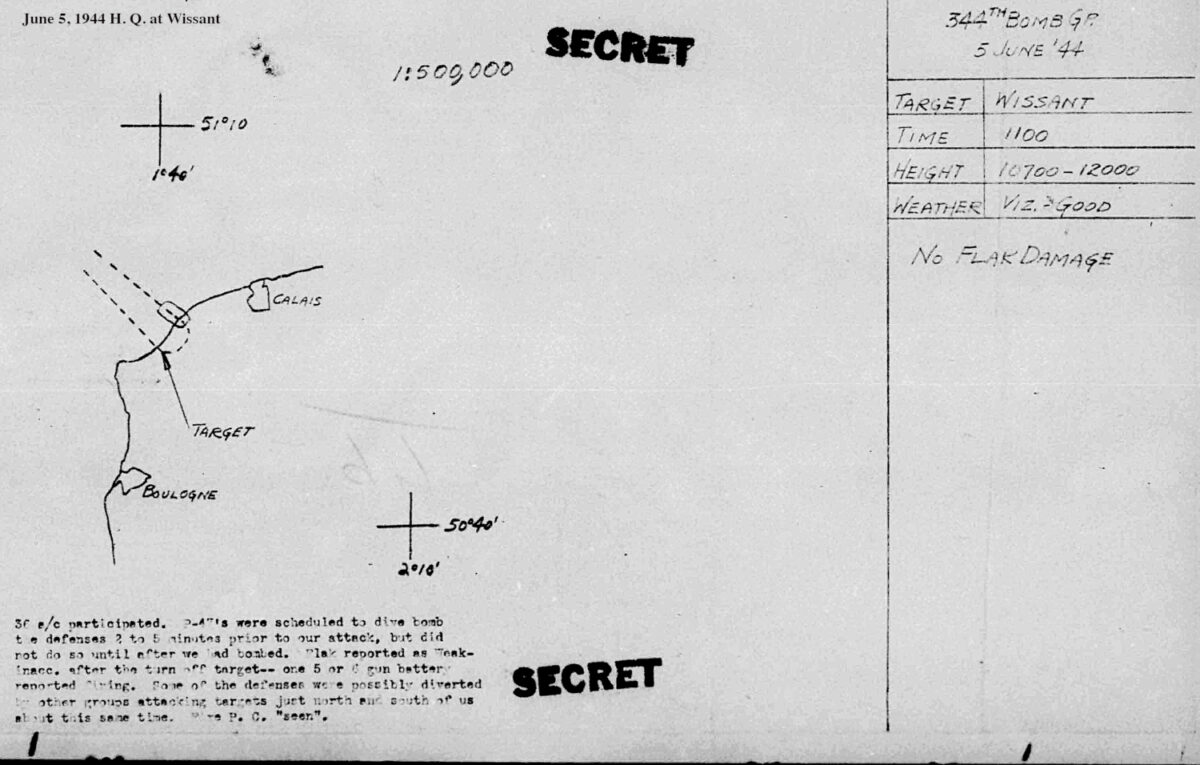
36 planes were in the formation. None received flak damage. At 3:55 pm the bombs were dropped from about 10,700 ft. The visibility at the target was very good. The formation expected to be have enemy defenses weakened by dive-bombing P-47 Thunderbolts. However, they did not do so until after the bombing. Even so the flak was weak and inaccurate.
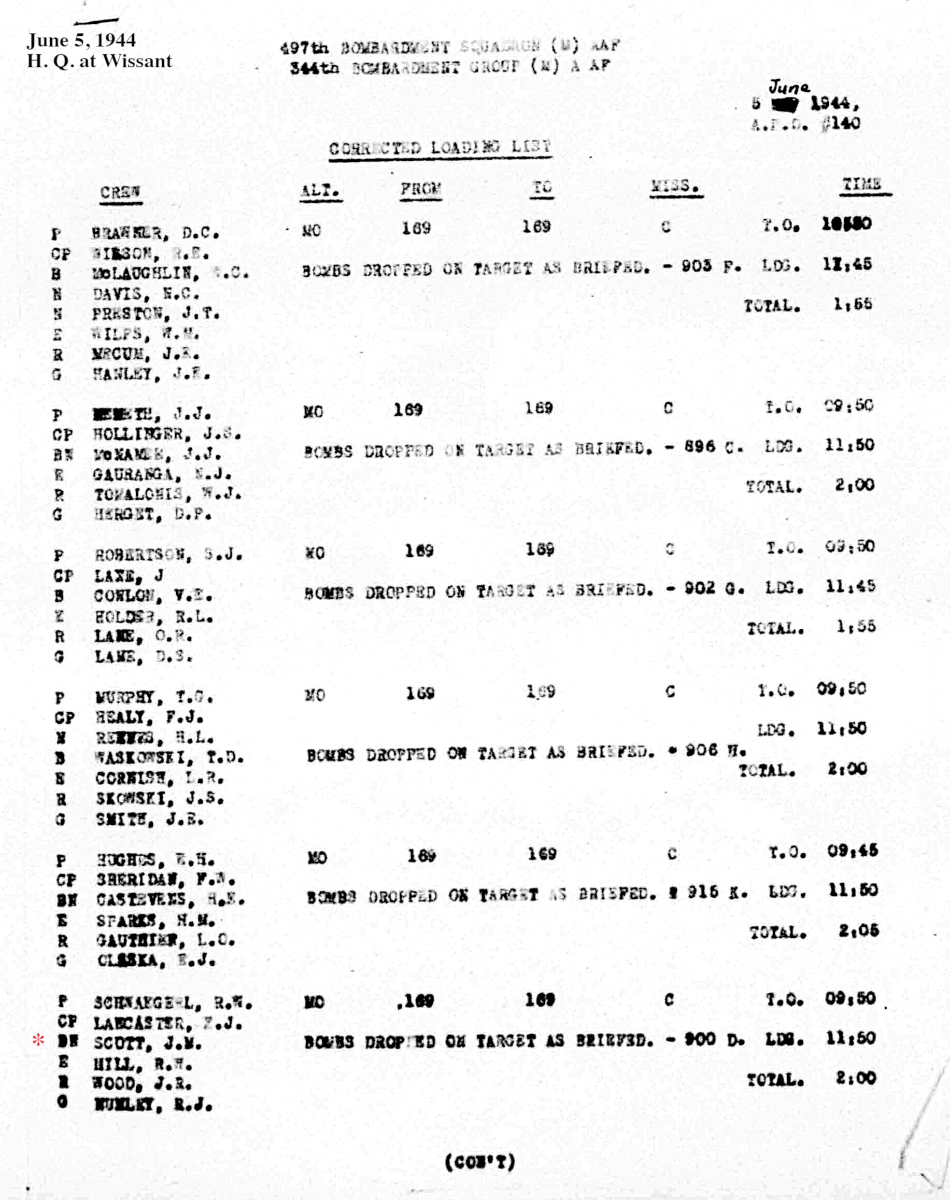
The mission of June 5, 1944 was to attack enemy headquarters at Wissant, France. Their plane took off at 9:50 am and landed 11:50 am. The plane used can not be determined by available records. The crew consisted of;
PILOT – Schnaegerl
COPILOT – Lancaster
TOGGILIER- Scott
RADIO/GUN – Wood
ENG/GUN – Hill
TAIL/GUN – Nunley (sp?)
June 6, 1944 D-Day proved to be the final flight for Sgt. Jesse Scott and crew.
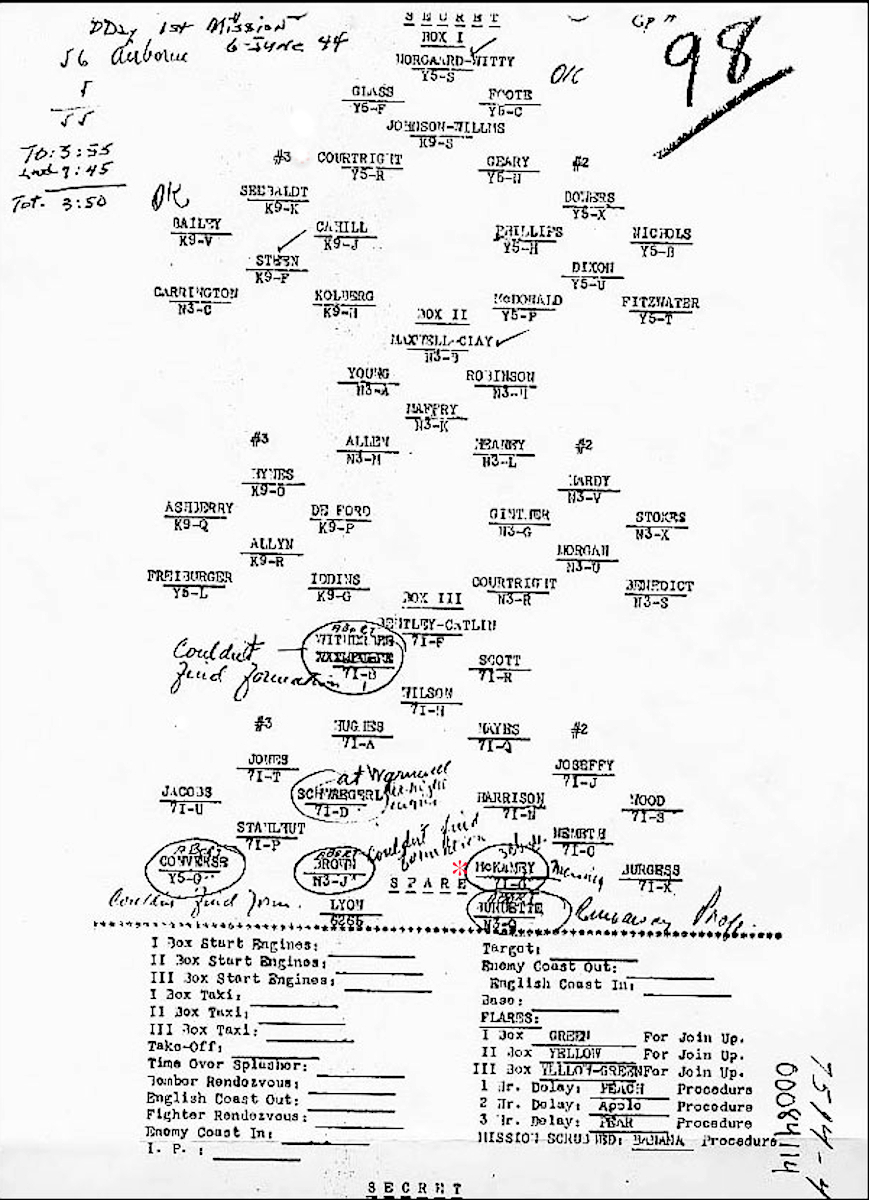
According to the formation diagram, Scott’s plane 7I-G was piloted by 2nd Lt. James Burton McKamey in position 3-2-6.
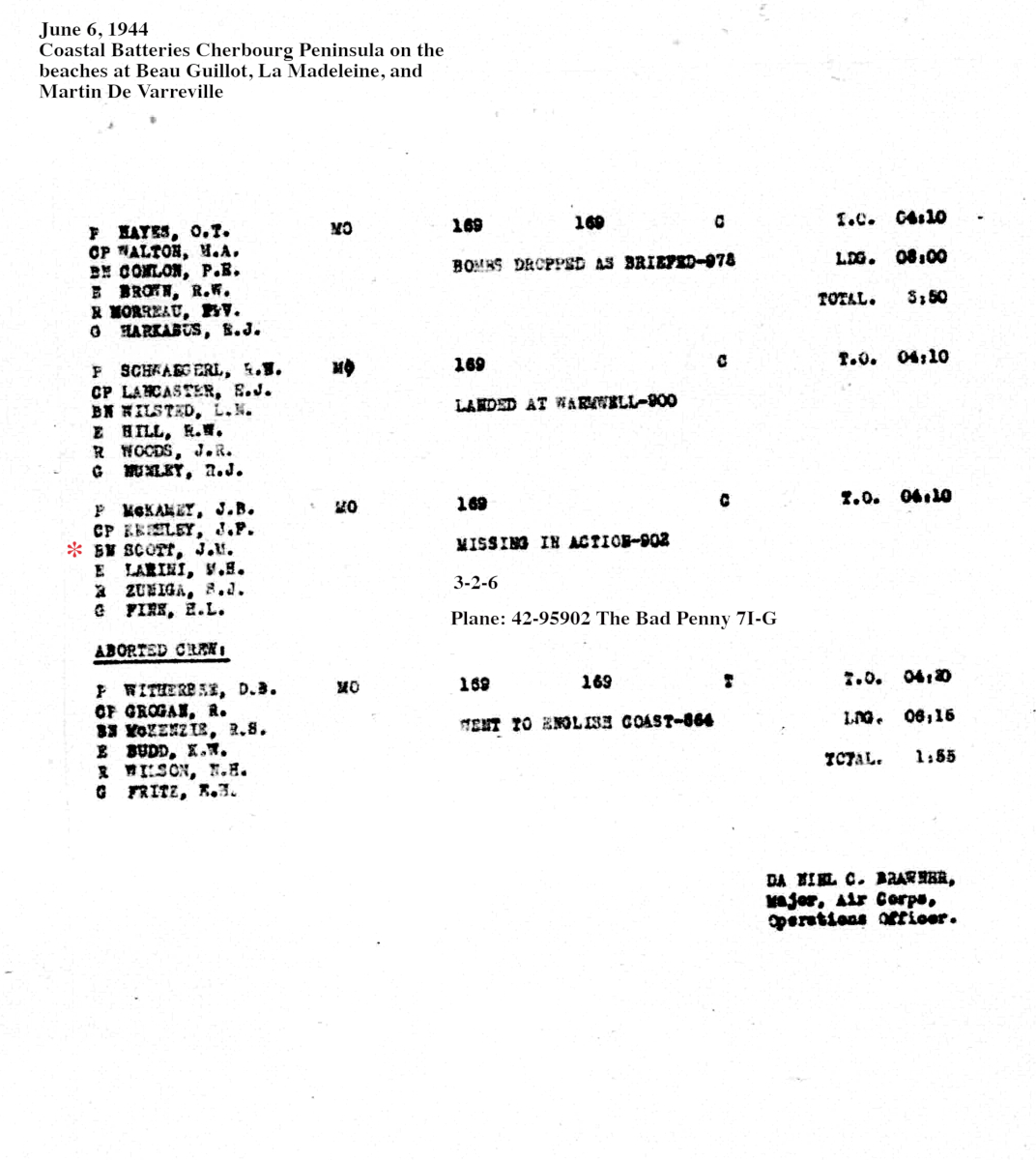
The first mission on D-Day June 6, 1944 was to attack coastal batteries on Utah Beach, Cherbourg Peninsula at Beau Guillot, La Madeleine, and at
Martin De Varreville. The plane that pilot McKamey, Jesse Scott and crew used was 42-95902 The Bad Penny 7I-G. The plane took off at 4:10 pm and were shot down by enemy flak. The crew consisted of;
PILOT – 2nd Lt. James Burton McKamey
COPILOT – F/O. John F Kechley
BOMBARDIER- Sgt. Jess McIntosh Scott
RADIO/GUN – S/Sgt. Salvadore Joseph Zuniga
ENG/GUN – S/Sgt. Manuel Huerta Larini
TAIL/GUN – Sgt. Howard Letford Finn
The debrief form below by pilot Hayes reports the loss of Scott and crew.
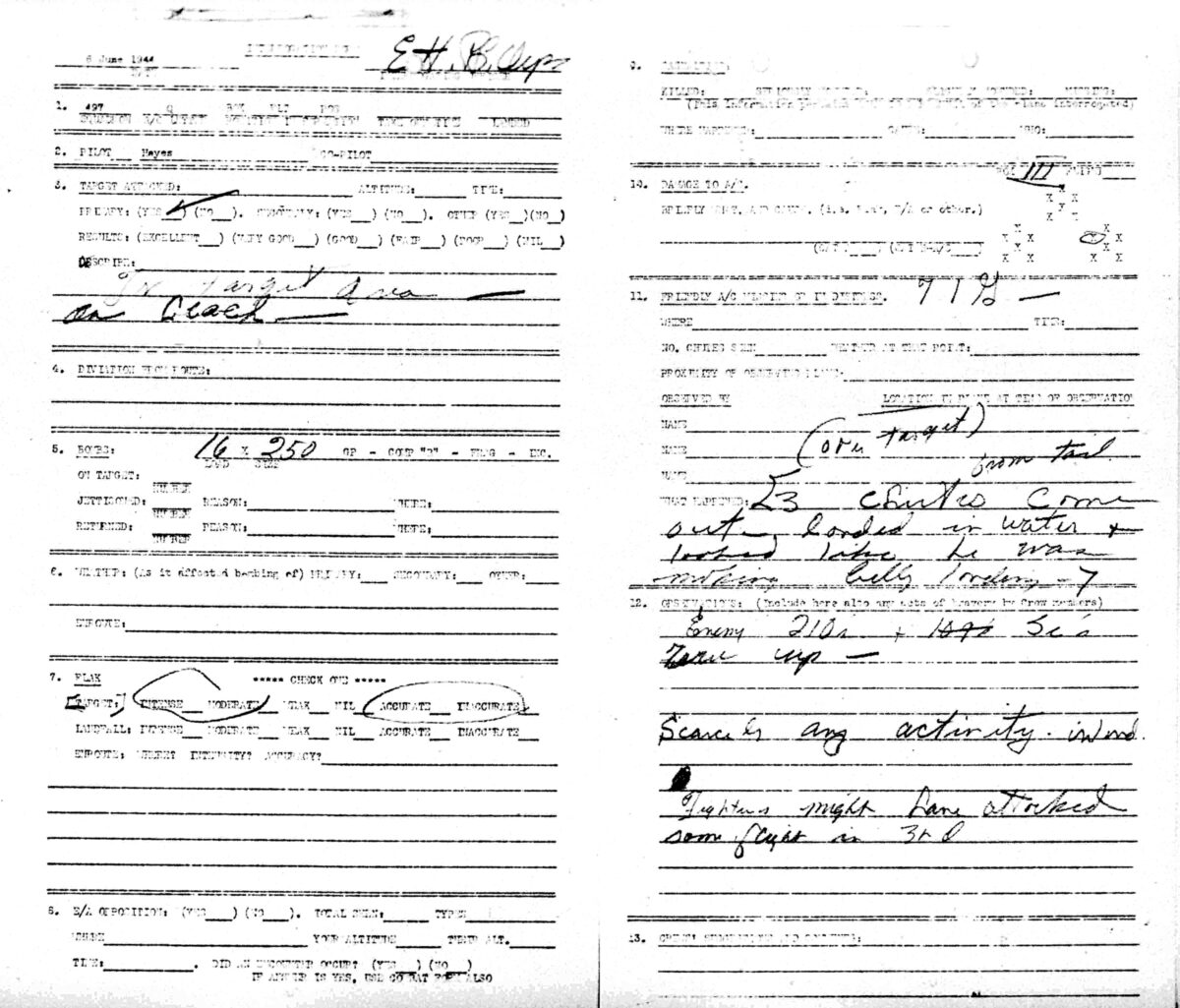
Hayes attacked Utah Beach as assigned dropping 16 x 250lb bombs. The enemy flak was intense and accurate. Hayes and/or crew observed a plane shot down with three parachutes leaving the tail section. The plane landed in the water as if making a belly landing.
One report says that the three parachuting crewman were killed by German machine-gun fire as they floated down. Leaving McKamey, Kechley, and Scott to go down with the plane.
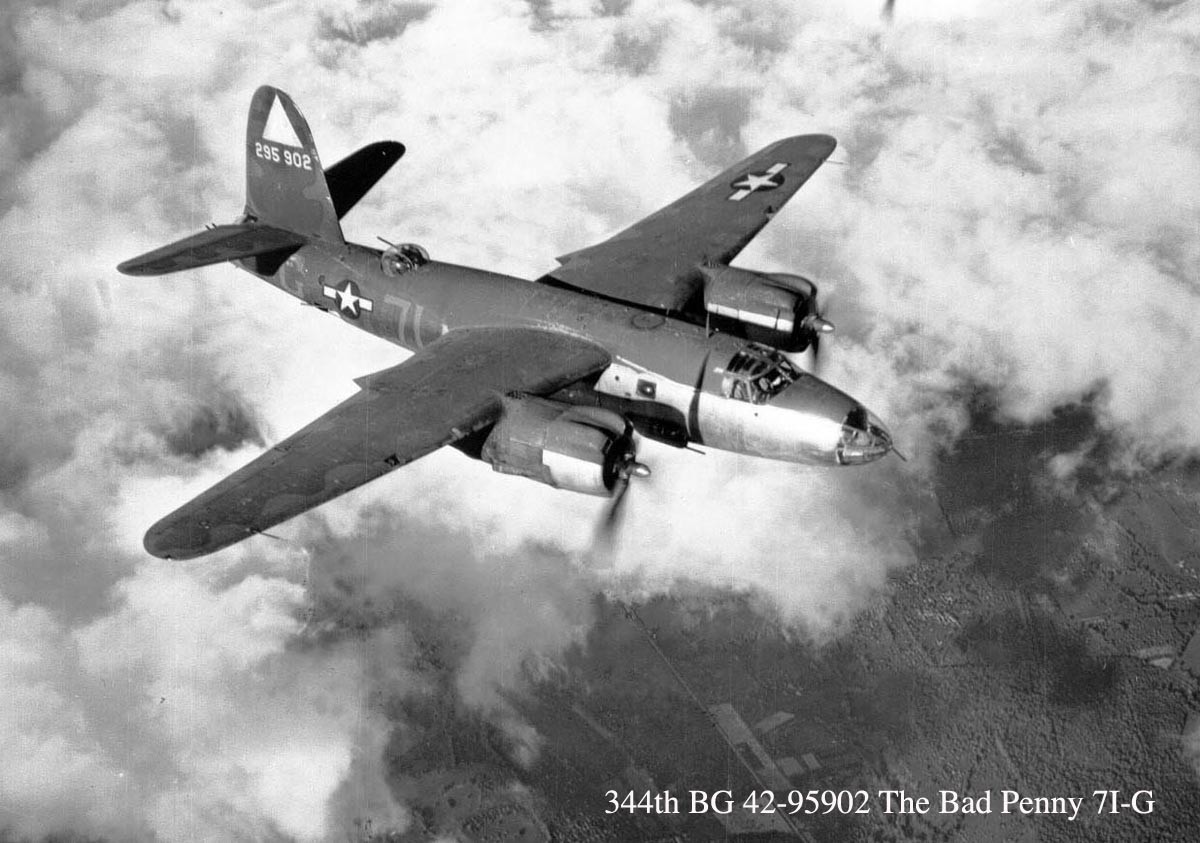
The detailed MACR report of the crash can be seen using this link.
The below is a summary:
344th MISSING CREW REPORT
MACR# 5656
DATE – 6 June 1944 06:09
MISSION – Beau Giullot , France D-Day
HIT BY FLAK NEAR TARGET
PLANE # 42-95902 7I-G “The Bad Penny”
344TH BG 497TH BS Station 169-S Stansted
PILOT – 2nd Lt. James Burton McKamey 922697(killed)
COPILOT – F/O. John F Kechley 933662 (killed)
BOMBARDIER- Sgt. Jess McIntosh Scott 39233319 – tail gunner flying as bombardier (killed)
RADIO/GUN – S/Sgt. Salvadore Joseph Zuniga 39268588 (killed)
ENG/GUN – S/Sgt. Manuel Huerta Larini 19106038 (killed)
TAIL/GUN – Sgt. Howard Letford Finn 36314543 (ordnance ground crew flying as tail gunner (killed)
Links:
http://shopwornangel.imaginarynumber.net/wp-content/uploads/2014/03/344TH-497TH-42-95902-The-Bad-Penny-7I-G.jpg
http://shopwornangel.imaginarynumber.net/wp-content/uploads/2014/03/Bad-Penny.jpg
https://etvma.org/veterans/james-b-mckamey-10941/
http://shopwornangel.imaginarynumber.net/wp-content/uploads/2017/0/Milk-Run-June-2014.pdf
http://www.b26.com/marauderman/jens.a.norgaard.htm
344th Spread Sheet Info: Lost on the 6/6/44 D-Day mission to bomb coastal gun batteries overlooking Utah beach on the Cherbourg Peninsula, France. The aircraft flown by 2nd Lt. James Burton McKamey was hit by flak as it crossed the French coast on the way to the target which damaged the right engine and set the rear bomb bay on fire. Three chutes were spotted before the aircraft crashed and exploded just offshore from Moutebourg. Although three chutes were spotted which came down in the water, there were no survivors.
From 344th BG history edited by Austin Lambert: The DD mission was not without loss for as one of the flights made enemy landfall, flak from the enemy was encountered. One plane of the 497th squadron piloted by second Lieutenant James B Mckamey was struck in the right motor which caused a fire that appeared to envelope the bombay section of the plane. Three parachutes Were seen to leave the plane as it pulled out of the formation and turned left out of the channel. Before its burden of
bombs could be jettisoned safe and allow the plane to be ditched in the water where rescue of which crew could be affected, the plane exploded in mid-air. Members of 2nd. Lieutenant McKamy’s crew were J.F. Keckley co-pilot, tail-gunner as bombardier Sgt. J.M. Scott, radio-gunner S/Sgt. S. J. Zuniga, engineer-gunner S/Sgt. M.H. Larini, ord. munitions as tail-gunner Sgt. H.L. Finn.
MACR Statement: Destination Paris railroad bridge. Slight haze visibility 15 miles. Plane last sighted by William Hildebrand, Alois Decker, and LeRoy Weaver.
Eyewitness description;
Plane was hit in the left engine by flak on the bomb run. Plane was flying
number 5 position in first flight, first box but pulled into number 4 position when hit, peeled off to the right with engine smoking. It left formation with wheels down and appeared to be in a dive when last observed. Three parachutes were observed to come from the plane. There was no reported observation of the plane crashing.
MACR Eyewitness Description by Tail-Gunner Anthony J. Paulino 497th BS: Right engine and forward bombay of plane was hit by Flak, plane pulled left out of formation, three parachutes immediately left the ship from the rear. There was a fire in the forward bombay. I saw the plane explode approximately 3 1/2 minutes after it left formation.
Parachutes would have landed between a small island in the North Sea and the mainland of France. At the time the chutes were just descending, there was a terrific tracer fire from enemy ground opposition.
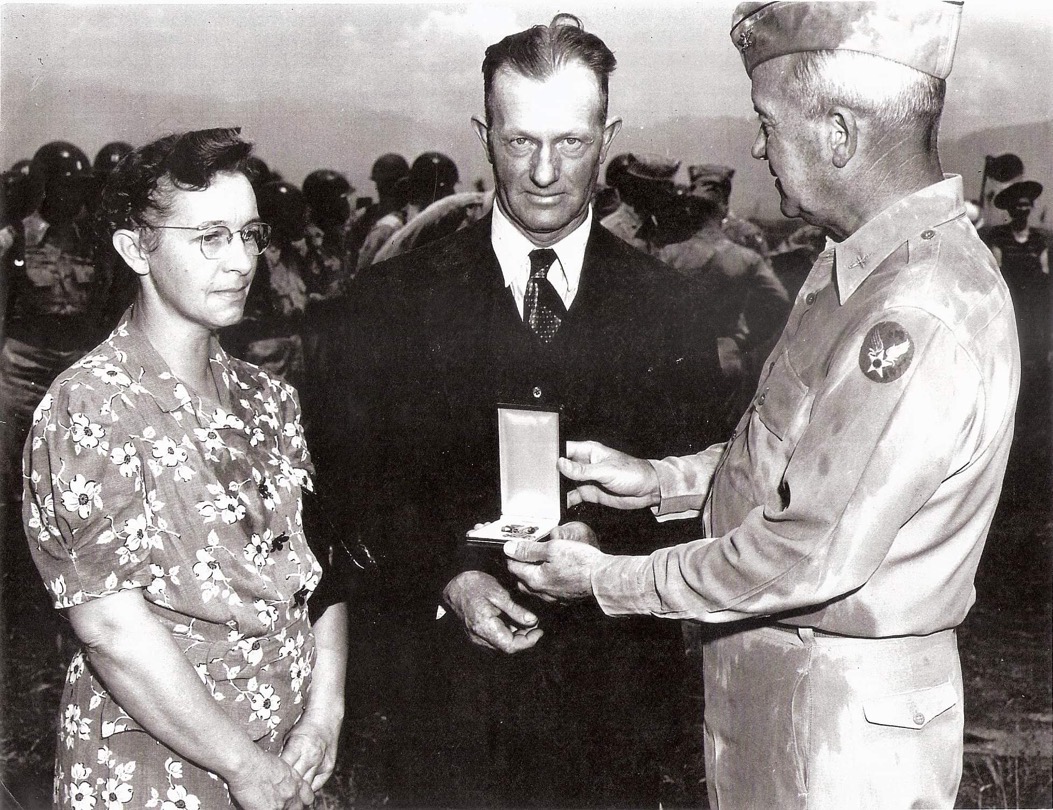

JB and his crew completed their first combat flight on 6 March 1944. Their mission along with the 344th was to bomb a German Airfield at Bernay St. Martin, France. They continued attacking airfields, missile sites, marshalling yards, submarine shelters, coastal defenses and other targets in France, Belgium and Holland until the beginning of May. At this point their
mission changed to help prepare for the Normandy invasion by striking vital bridges in France. On D-Day, 6 June 1944 the 344th was the lead group for the entire 9th Air Force attacking German coastal batteries at Cherbourg and along Utah Beach. This day JB and the crew flew in a Marauder named “The Bad Penny”. As they passed over Utah Beach “Bad Penny” was hit by anti-aircraft fire (FLAK) at 0609 (6:09am). JB pulled left out of the formation with his right engine and bombay on fire. He hit the bail-out alarm and three crew members left the rear of the ship. They were killed by German machine-gun fire as they floated down. JB, the co-pilot and the bombardier stayed with Bad Penny as to get her back past the Allied flotilla, salvo the bombs and bail-out themselves, but she exploded around three and one-half minutes later falling into the English Channel near the coastline at Montebourg, France. These three were never seen again, but the three that were shot by the Germans were later returned to their
loved ones for burial.
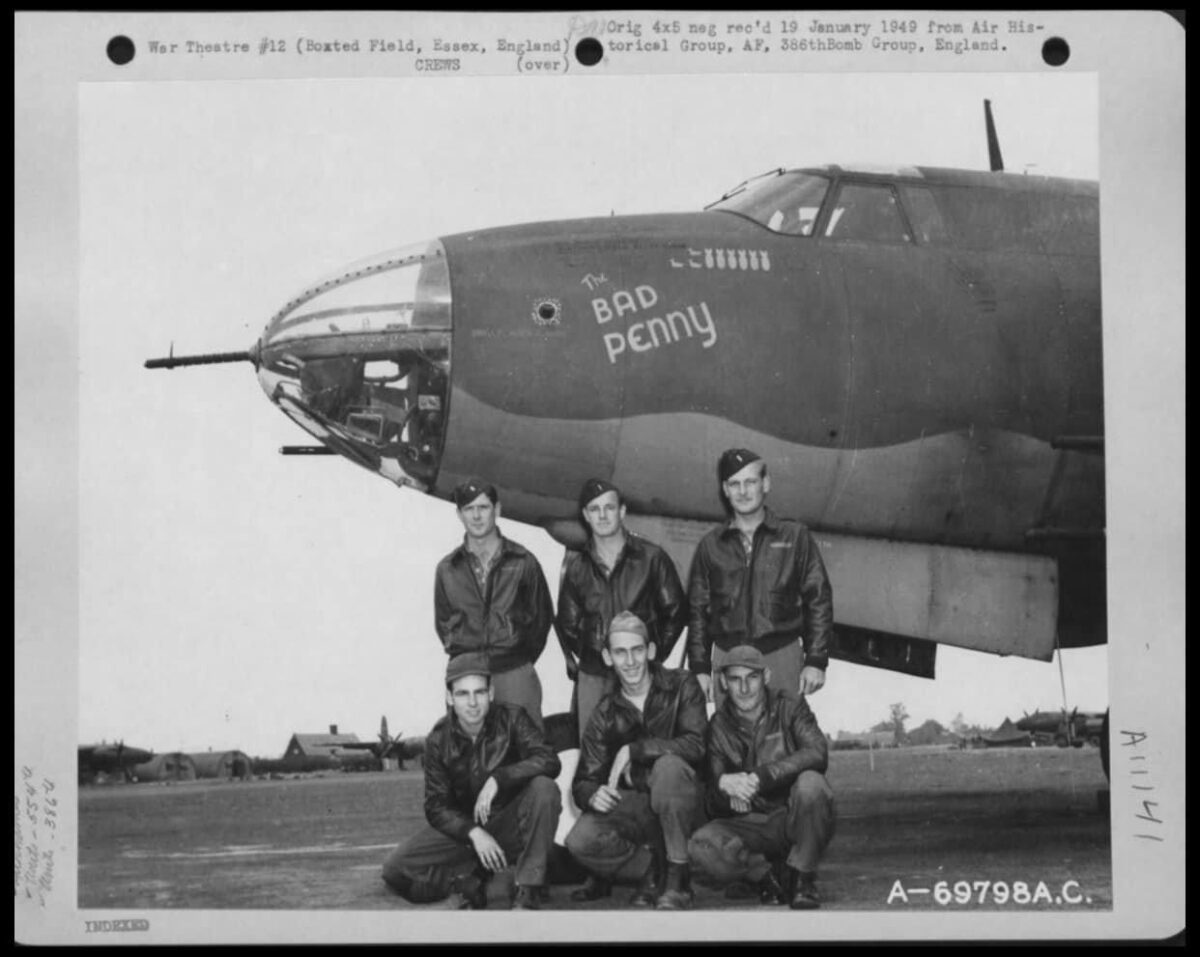
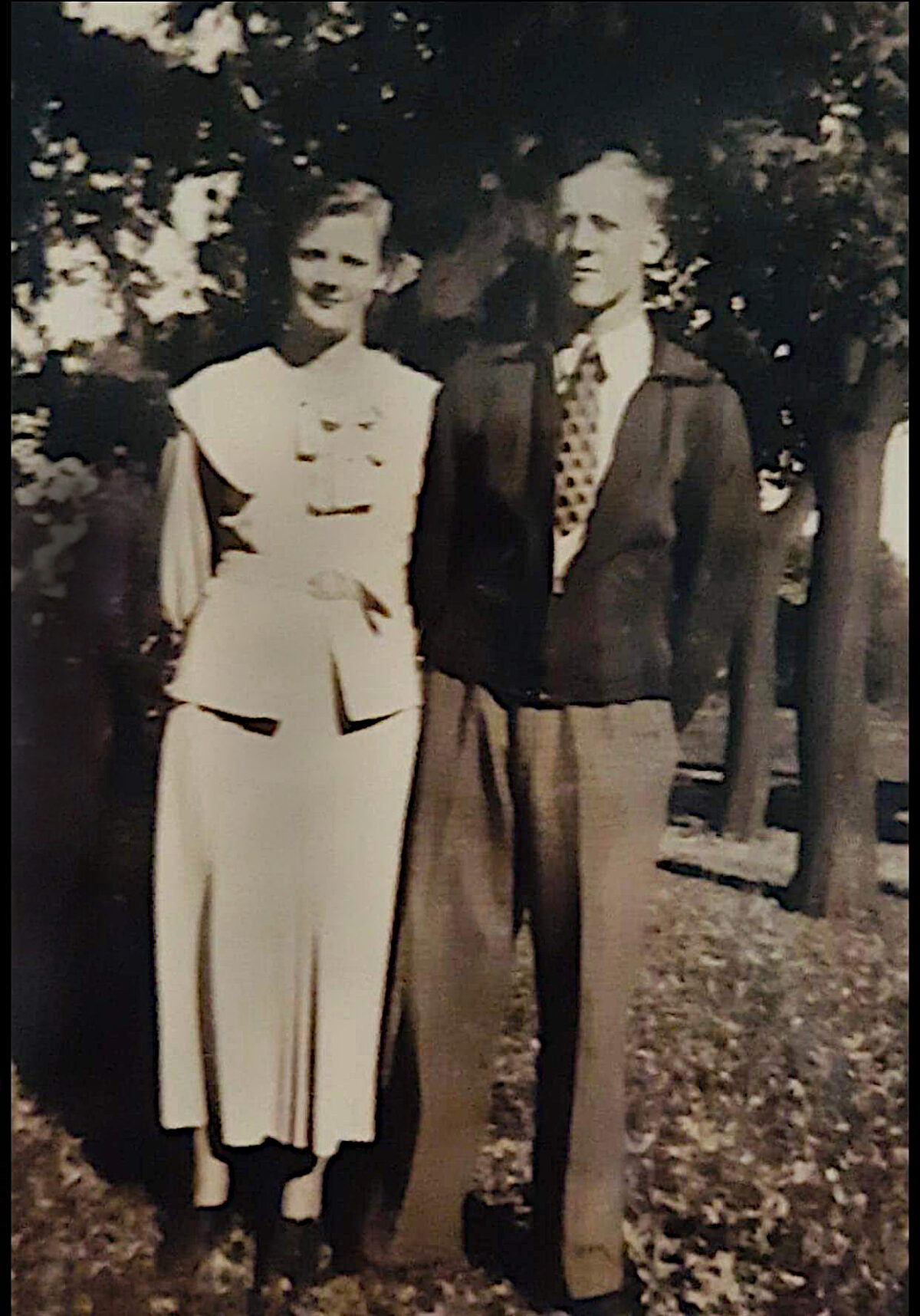
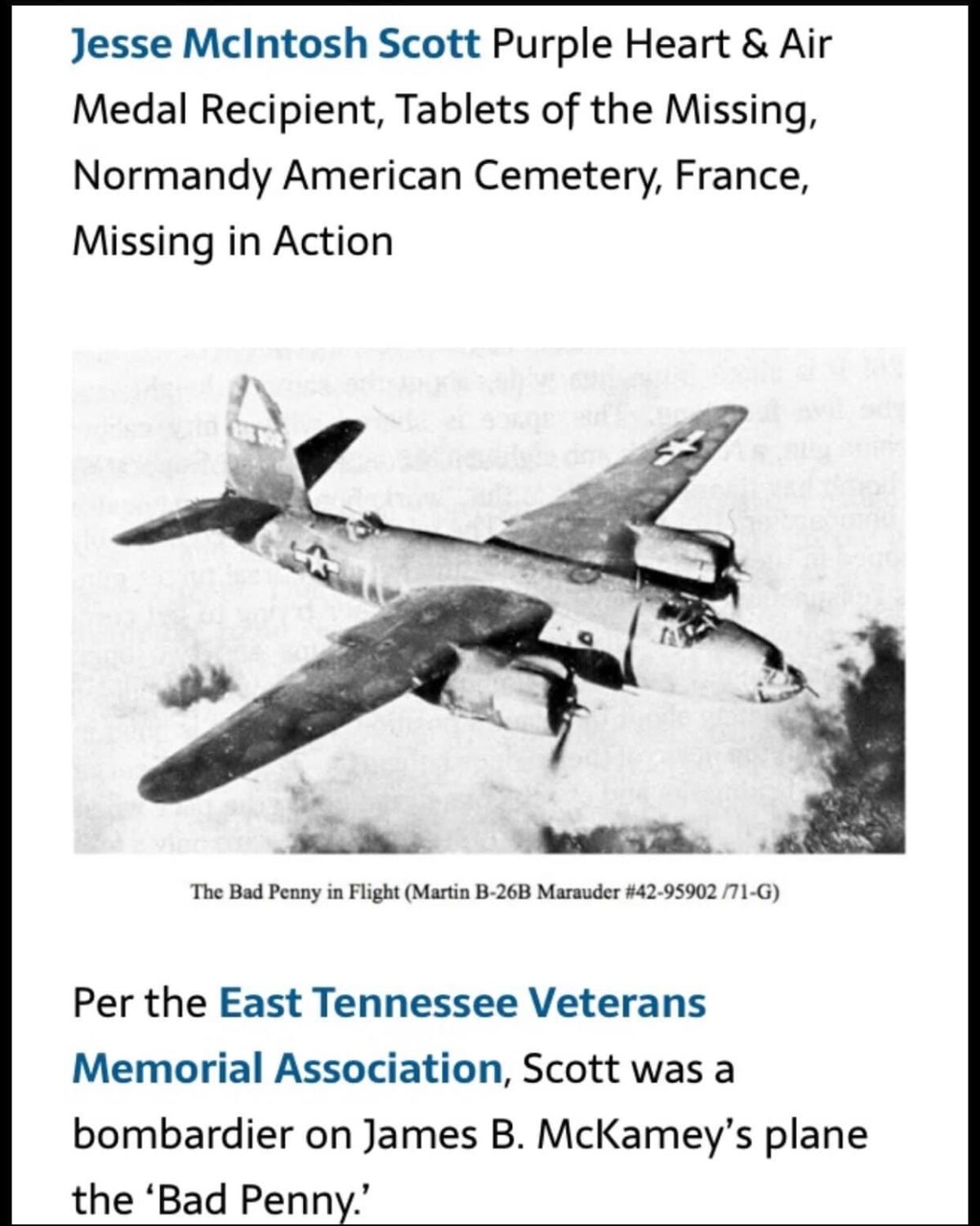

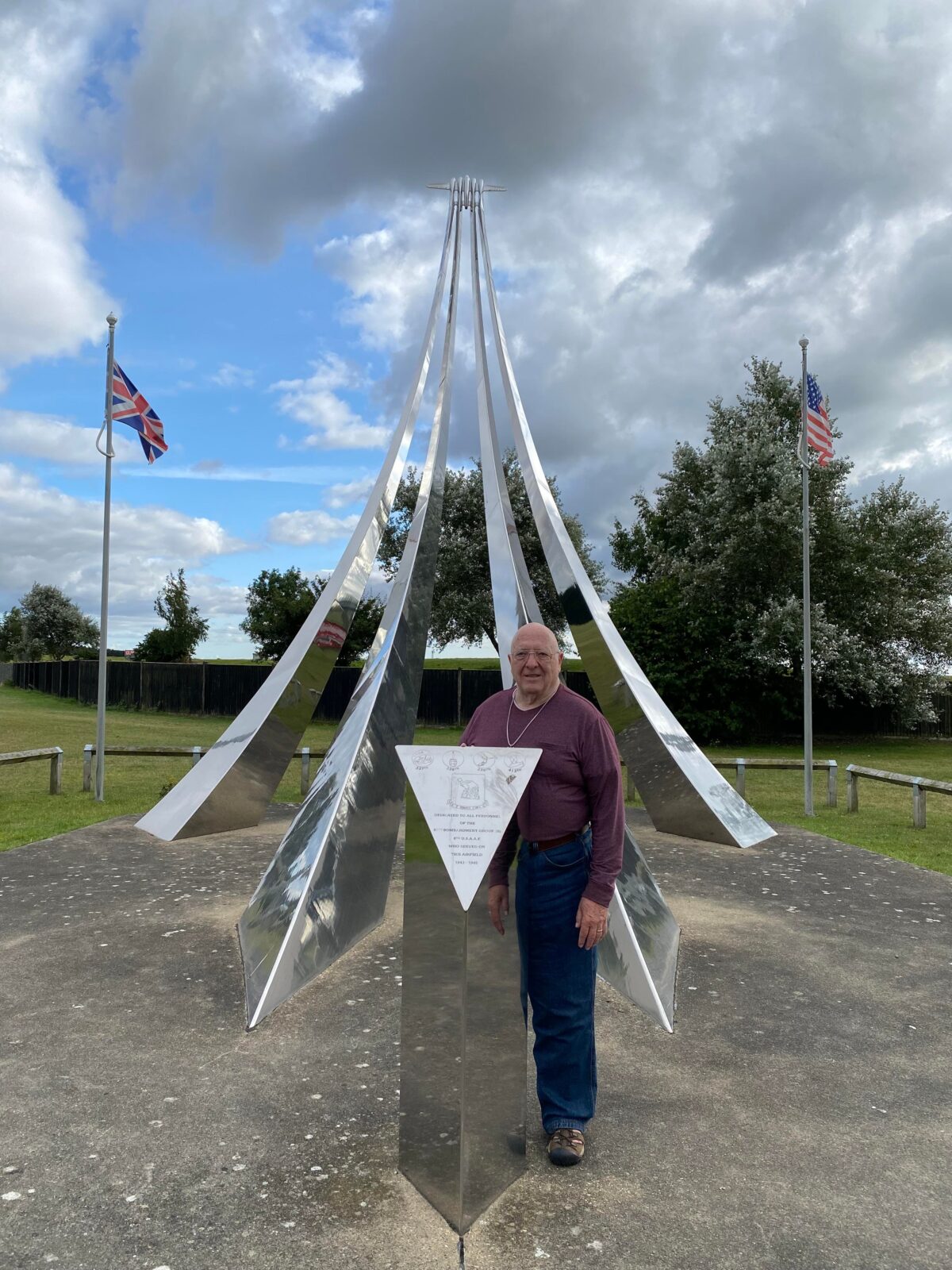
Thanks to Randy de Mars for providing the pictures for this profile.


